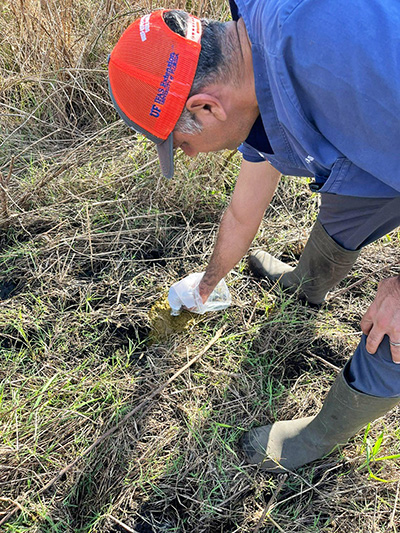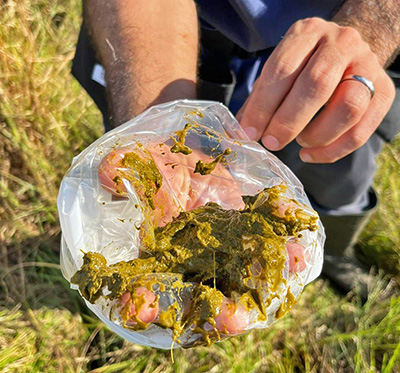
Fresh fecal collection in a pasture near Lorida, Florida. The technician waited for the cow to defecate and then collected a fresh fecal sample from the ground. Credit: João Bittar, UF/IFAS Bittar

It is important to collect fresh fecal samples without contaminants (sand, mud, or dirt). Credit: João Bittar, UF/IFAS Bittar
It is not new news that the beef industry in the Southeastern U.S. is predominantly made up of cow-calf operations. The total economic impact of Florida cattle ranching totals $2.1 billion annually (FDACS). A key goal of cow-calf operations is to limit the impact of parasites on the calves they produce. The sub-tropical environment and management practices of the cow-calf operations in Florida lead to an increased risk of parasite infestation almost all year around, especially gastrointestinal (GI) worms.
Beef cattle producers may use deworming in a way that can challenge the drug efficacy and potentially compromise the results and effectiveness of current commercially available dewormers and deworming protocols. In addition, the risk of antiparasitic resistance can be augmented. Therefore, it is important to understand the most common parasites affecting cattle, what deworming protocols are being used, and, more importantly, their effectiveness. Also, it would be beneficial to update the surveillance data collection of F. Hepatica (known as “Liver Fluke”) after more than a decade of relaxation on its preventive drug treatment. This cattle worm can cause damage to the liver, which opens up doors to some pathogens that can infect and make cattle sick. In the case of “liver flukes,” its damage to the liver creates opportunity for a bacteria called Clostridium haemolyticum to infect the cattle. This bacteria can cause the “red water” disease in cattle, for which there is no effective treatment, and can have a hard impact on cattle production. Thankfully, vaccination is an effective way to prevent this infection.

It is important to properly store samples (cooler or refigerator recommended) before sending them to the diagnostic laboratory. Credit: João Bittar, UF/IFAS Bittar
Several dewormers are available to be used in the U.S., but very few new products have been released on the market. These bring some challenges to the cattle industry, so stewardship of cattle parasite control is crucial. Some aspects can be important for the producers in the parasite control matter, such as understanding the type of dewormer used (dewormer classes), the time of the year in which the parasite loads in the environment are lower, cattle category susceptibility to parasites, risk factors cattle are under, and basic knowledge of parasite cycle. Therefore, we strongly recommend closely consulting your veterinarian to develop adequate parasite controls and, most importantly, to evaluate their efficacy.
A simple and effective way to evaluate the product (s) and protocol (s) used to control GI parasites is by conducting a Fecal Egg Count Reduction Test (FECRT). Basically, we need to collect feces from a representative group of cattle right before the day of deworming (or the day of) and a second set of samples two weeks after the day of deworming. These samples will be used to determine the parasite’s egg load, which will give trustful data to calculate the FECR after cattle are dewormed. The result is presented as a percentage of reduction in the egg load in the feces and can be used to evaluate the efficacy of cattle deworming to provide feedback to the producers.
To learn more about the ongoing University of Florida College of Veterinary Medicine’s study that aims to collect data about GI parasites and deworming protocols and their efficacy in cow-calf operations in Florida, utilize the following link:
Cow-Calf Parasite & Infectious Diseases Study
- Leptospirosis in Cattle:Why You Should Know More About It? - July 11, 2025
- Dangers of Toxic Algae Blooms for Cattle: Risks and Prevention Strategies - December 20, 2024
- Gastrointestinal (GI) Parasites of Beef Cow-Calf Operations in Florida - June 14, 2024
